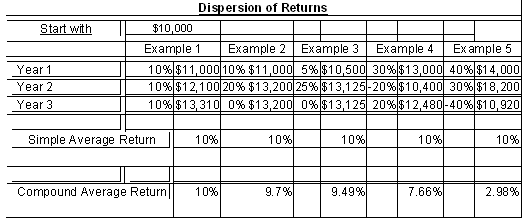

Is your portfolio beating the stock market average annual return? Maybe it is has to do with how the stock market average annual return is calculated.
Looking at the averages can be misleading for followers of baseball as well as investing. Your team’s batting average may be the best in the league until they encounter the pitcher with the best Earned Run Average (ERA). Investors who expect to receive the stock market average annual return each year will be disappointed.
Many investors take it as truth that October is the worst performing month of the year. Yet looking at the average monthly returns for the stock market back to 1926 and it turns out that September has historically been the worst month, with an average return of -0.75%. Just like the best hitting team that encounters the best pitcher, September 2009 ignored the averages and turned in a respectable 3.7%. You cannot count on the averages being right every time.
Speaking of averages, according to various reports the stock market average annual return is approximately 8% over the 81 years ending in 2008. Many mutual funds and investment advisors like to use average annual returns, as it allows them to use a higher number. When confronted with this situation ask them is that the simple average or the compound average. It makes a difference, as the compound average is about 7% and is the more relevant number as we will discuss shortly. Many investment advisors use average stock market returns to convince their clients to invest with them in the market. The problem is not every year delivers this average return. A history lesson might be in order.
In the last 83 years, the stock market lost money in 28 of those years. Even worse, it lost more than 20% in eight of those years and four different times the market fell one-third during that year. Ouch.
When looking at the stock market average annual return there are several important factors to understand. One is the affect of the dispersion around the mean. The second is how negative returns, i.e. losses, really hurt your return. The calculation of average annual returns does not take into consideration the affect of these two factors. The compound return includes them so the number accurately reflects the return you should expect.
When the returns in a series of numbers become more dispersed from the average, the compound return declines. The greater the volatility of returns, the greater the drop in the compound return. Some examples will help to demonstrate this phenomenon. The table below shows five examples of how the dispersion of returns affects the compound rate.
In each case, the simple average is 10%, while the compound average declines as the dispersion of returns widens. In each of the last two years, the market experienced losses. A loss widens the dispersion of the return, which lowers the compound average.

Half the time the stock market moves up or down by 16% or more in a year. Think back to the returns we have seen in the market over the last few years. They more closely reflect years of positive and negative returns similar to Examples 4 and 5.
Another consequence of losses in the market is it takes a much greater return to recover to where you began. If you earn 10% in the first year and then lose 10% in the second year you still have a loss over the two years as the first example shows. Moreover, if you lose 50% in one year, you must generate a 100% return to just breakeven. A very difficult proposition.

Therefore, the message is to be very careful and not lose money. When you do, you must generate greater returns to break even, let alone make any money. No wonder Warren Buffett’s first rule of investing is do not lose money.
In baseball, your hitting average does not tell the entire story. The same is true with investing. Be careful when listening to those who espouse they are beating the stock market average return. Moreover, keep your losses small. When you have gains, be sure to protect them. That way you make compounding averaging work for you and you will experience positive stock market average returns.
Our Premium Members receive weekly updates on important and relevant trends for the stock market, industry sectors and individual stocks and ETFs. By following the trends and using fundamental analysis, we have beat the market every year since our inception. You should give our four-week free trial to the Premium Membership a try. There is no risk, nor any obligation. If you have any questions regarding membership, please send an email to [email protected] and we will get right back to you. Your complete satisfaction is of utmost importance to us.